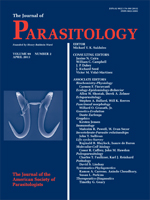Exposure to parasites is considered to be an important factor in the development of many diseases and histopathologies which are the result of the parasite–host interaction. The present study evaluated the impact of natural infection by larvae of Ortleppascaris sp. (Nematoda: Ascaridida) in the liver of the cane toad Rhinella marina (Linnaeus, 1758). Larvae were encysted in nodules delimited by collagenous fibers and fibroblasts or freely within the hepatic parenchyma, provoking a clear response from the host. The histological examination of the liver revealed viable larvae in a number of different developmental stages, as well as cysts filled with amorphous material and cell residues and surrounded by dense fibrotic tissue. The infection of the liver by these larvae induces a significant increase in the area occupied by melanomacrophages and a reduction or deficit in the vascularization of the liver, hypertrophy of the hepatocytes, vacuolar bodies, and cytoplasmatic granules. Focal concentrations of inflammatory infiltrates were observed enclosing the unencapsulated early-stage larvae. These results indicate that infection by Ortleppascaris sp. induces severe physiological problems and histopathological lesions in the liver of R. marina.
How to translate text using browser tools
1 April 2013
Liver Histopathology in the Cane Toad, Rhinella marina (Amphibia: Bufonidae), Induced by Ortleppascaris sp. Larvae (Nematoda: Ascarididae)
Jefferson P. E. Silva,
Djane C. B. da Silva,
Francisco T. V. Melo,
Elane G. Giese,
Adriano P. Furtado,
Jeannie N. Santos
ACCESS THE FULL ARTICLE

Journal of Parasitology
Vol. 99 • No. 2
April 2013
Vol. 99 • No. 2
April 2013




